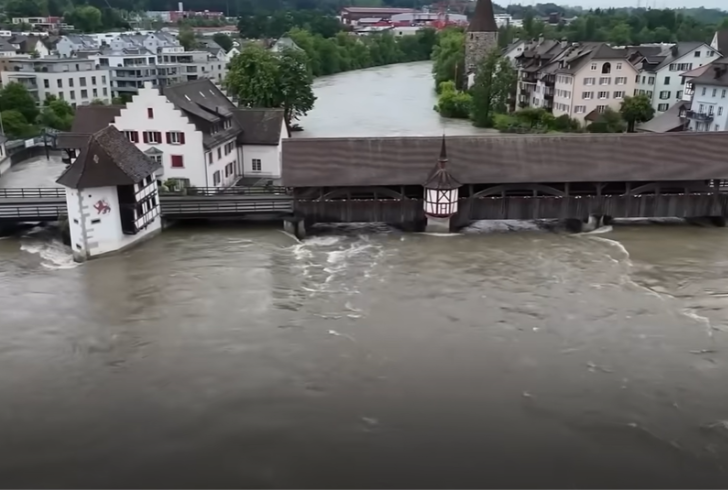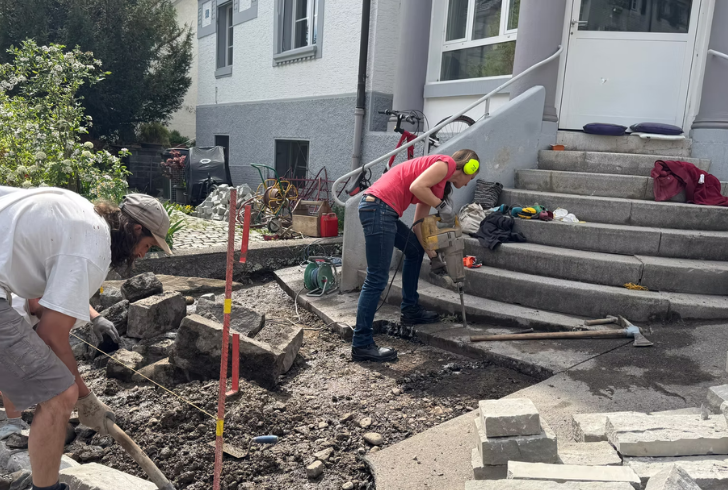Climate extremes are hitting harder across Europe, and Switzerland is feeling the strain. Torrential rain, flooding streets, and intense heat waves aren’t just the work of climate change—they’re also the result of how cities have been built.
Sealed surfaces like concrete and asphalt are choking the earth, preventing water from being absorbed into the ground. But Swiss cities are starting to rethink urban design—and they’re doing it with shovels, jackhammers, and a whole lot of native plants.
Swiss Activists Are Digging Up Change
In cities like Zurich and Winterthur, a grassroots movement is pushing back against concrete. Known as the Asphalt Crackers, a group led by former journalist Bettina Walch and biologist Isabelle Sadey V is tearing up paved areas and helping urban communities reintroduce native vegetation. Their approach is simple but impactful: remove hard surfaces, bring in healthy soil, and let nature do the rest.
These changes aren’t just for show. In crowded city blocks, tiny courtyards that once held parked cars are being reimagined as shared gardens. Asphalt is giving way to gravel paths, and patches of wildflowers are blooming where engines used to idle. It’s not just prettier—it cools the neighborhood down and helps rainwater drain into the soil instead of flooding the streets.
The Swiss Parking Problem

YouTube | DW News | Paved parking in Switzerland, covering 64 sq km, drives urban heating, runoff, and flooding.
Switzerland currently has around 64 square kilometers of parking space, which equals nearly 900 soccer fields. These paved zones hold heat, prevent water absorption, and contribute to urban flooding.
Across Switzerland, people are starting to rethink all that concrete. Parking lots in residential areas are being replaced with green spaces, and homeowners are getting involved too, turning driveways and courtyards into small gardens. In places like Winterthur, the local government even covers the cost of tearing up old concrete to support these changes.
It’s not just about going green—it’s about preparing for a future where storms are harder to predict. That’s where the “sponge city” model comes in: using plants, gravel, and soil to soak up rainwater before it floods the streets.
What Happens When Concrete Is Removed
The difference is immediate. In one Winterthur neighborhood, a former asphalted area has been reshaped into a shared family space with greenery and seating. Children now play where cars once sat. Flowers bloom. And when the rain comes, the water doesn’t flood the street—it sinks into the ground.
In Sovingen, northern Switzerland, a flash flood in 2017 damaged homes and overwhelmed local infrastructure. Since then, the city council has steadily replaced sealed streets with plant-covered areas. It’s working. Water is now being absorbed by the soil instead of rushing off the pavement into basements and train stations.
These changes bring multiple benefits:
1. Reduced heat – Vegetation naturally cools surfaces that would otherwise bake in the sun.
2. Improved biodiversity – Native plants support pollinators and other wildlife.
3. Better water absorption – Rain soaks into the ground rather than flooding streets.
4. Healthier neighborhoods – Green spaces improve mental well-being and encourage social connection.
Public Awareness Through Activism

asphaltknackerinnen.ch | Walch and Sadey V engage residents and also provide online scientific guidance via their website.
Walch and Sadey V aren’t just working with residents. They also share their projects online, offering guidance and scientific insight through their website.
The message couldn’t be simpler: without healthy soil, we lose the basics—food, clean water, and even natural ways to cool our cities. And with nearly a third of the world’s soil already damaged, bringing green spaces back into urban areas is one way to start repairing it. By highlighting Swiss neighborhoods where change is already happening, they’re nudging public opinion in the right direction. This isn’t just about pretty parks—it’s about building cities that can actually withstand the future.
Why This Movement Matters
Switzerland’s dramatic landscape—steep hills and narrow valleys—makes it especially prone to extreme weather. And while climate change is a global problem, how cities are designed plays a local role. Paved-over streets and parking lots prevent rain from soaking into the ground. Instead, the water overwhelms drains, floods basements, and causes expensive damage.
The solution isn’t to get rid of all pavement—it’s to rethink how it’s used. By mixing natural elements with smart city planning, Swiss towns are finding a better balance: cooler, greener neighborhoods that can handle what’s coming.
Restoring Soil, One City at a Time
The work taking place in cities like Zurich, Winterthur, and Sovingen shows that reversing the damage of urban sprawl is not only possible but also practical. Removing a patch of asphalt may seem small, but multiply that by thousands of lots and streets, and the impact becomes massive.
Swiss initiatives like these are setting a blueprint for urban spaces around the world. It’s not a trend—it’s a return to something cities desperately need: breathable, absorbent, life-giving ground. And it all starts by cracking open what’s been sealed shut for too long.




